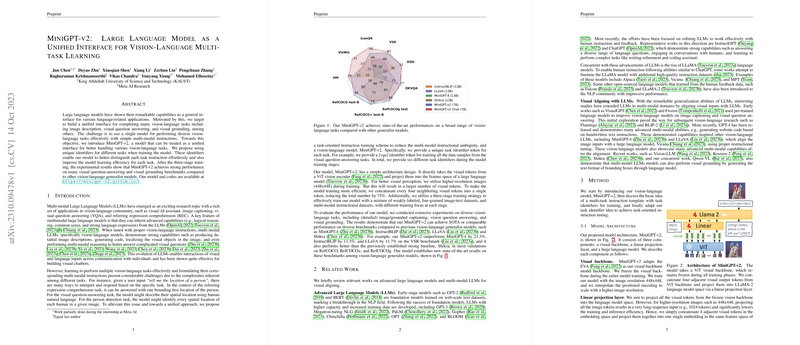Overview of MiniGPT-v2: A Unified Interface for Vision-Language Tasks
The paper "MiniGPT-v2: LLM As a Unified Interface for Vision-Language Multi-task Learning" presents a novel approach for integrating vision and language processing tasks using a single model. This work addresses the complexities inherent in performing diverse vision-language tasks such as image description, visual question answering (VQA), and visual grounding, using a unified framework.
Model Architecture
MiniGPT-v2 operates by utilizing a unique task identifier system, allowing the model to distinguish between different vision-language tasks efficiently. The architecture comprises a visual backbone, a linear projection layer, and a LLM, specifically adopting LLaMA2-chat (7B). A critical feature is the aggregation of visual tokens, which optimizes computational efficiency by condensing 75% of token input length. The model is trained using high-resolution images (448x448), enhancing visual perception capabilities.
Training Strategy
The model undergoes a three-stage training process:
- Pretraining: Initial exposure to both weakly-labeled and fine-grained datasets aims to build a broad vision-language knowledge base.
- Multi-task Training: This stage focuses exclusively on fine-grained datasets to refine task performance, ensuring more precise task execution across various vision-language tasks.
- Multi-modal Instruction Tuning: The model is trained with specific instruction datasets to enhance its ability to follow multi-modal instructions effectively, integrating both image and language datasets.
Experimental Results
The experiments highlight MiniGPT-v2's robust performance across various tasks compared to other multi-modal models:
- On visual question answering, it achieved top-tier accuracy, outperforming models like InstructBLIP and MiniGPT-4 on several benchmarks like VSR and OKVQA.
- In referring expression comprehension tasks, MiniGPT-v2 set new performance standards among generalist models, although not yet exceeding specialist models.
- The model showcases reduced hallucination compared to baseline models, achieving low scores on CHAIR metrics when generating detailed image descriptions.
Implications and Future Work
MiniGPT-v2 demonstrates significant advancements in unifying vision-language tasks in a single model interface, paving the way for more integrated approaches in artificial intelligence. The model's use of high-resolution images and task-specific identifiers enhances its adaptability to diverse tasks, suggesting a powerful tool for developing visual AI assistants and chatbots.
Future developments could focus on integrating stronger vision backbones, exploring larger LLM integrations, and minimizing hallucination in image-to-text tasks. Expanding the variety of datasets could further enhance model robustness, offering new prospects for applications in complex real-world scenarios.
In conclusion, MiniGPT-v2 represents a critical step forward in vision-LLM development, offering a unified framework that handles multiple tasks with notable efficacy and efficiency.
